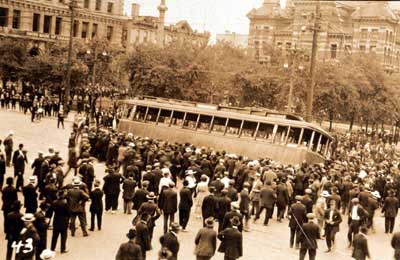 A part of Canadian history: the Winnipeg General Strike of 1919 |
According to many history books, Labour Day began in the United States when the Knights of Labor organized a parade on Sept. 5, 1882 in New York City.
As is often the case, the history books got one thing right and another wrong. The Knights did hold a parade in 1882, but the history of Labour Day began 10 years earlier, and in a place much closer to home.
On April 15, 1872, when Canada was just five years old, the Toronto Trades Assembly organized a “workingman’s demonstration” to call for the freedom of 24 imprisoned leaders of the Toronto Typographical Union.
The demonstration, which was attended by 10,000 people, included a parade and speeches that called for the repeal of a law criminalizing membership in trade unions.
Buoyed by the success of the demonstration, members of seven Ottawa trade unions organized a mile-long parade on Sept. 3, 1872, once again to protest laws that made union membership illegal.
But this wasn’t your average parade — marchers stopped at the home of then prime minister John A. Macdonald, literally picked up the PM, and took him to Ottawa City Hall by torchlight.
The prime minister was well aware of workers’ discontent with the law, and on the steps of the city hall, he promised marchers that his party would “sweep away all such barbarous laws from the statue books.”
Later that year, Mr. Macdonald and his party made good on his promise, and for the next decade, trade unions continued to hold annual parades and demonstrations.
On July 22, 1882, the Toronto Trades and Labour council decided to invite New Yorker Peter J. McGuire, the general secretary of the United Brotherhood of Carpenters and co-founder of the American Federation of Labour, to speak at the demonstration.
McGuire was duly impressed with the event, and, when he returned home, he proposed that America celebrate a day in honour of workers. Sure enough, the Americans celebrated their first unofficial Labour Day on Sept. 5, 1882, and McGuire became known as the “father of Labour Day.”
Over the next decade, individual states enacted legislation making the first Monday in September Labour Day, and on June 28, 1894, the U.S. Congress passed a federal law enshrining the holiday.
Just four weeks later, the Canadian Parliament enacted a similar law, and now the first Monday in September is celebrated as Labour Day throughout North America. Many other countries, including Australia, New Zealand and the Netherlands, also recognize Labour Day, but have chosen different dates on which the holiday is observed.
And still other countries recognize Labour Day’s spinoff — May Day — on May 1. But regardless of what it’s called, when it’s celebrated or who first made it official, Labour Day was clearly introduced to the world by Canada.
As with many holidays, the roots of Labour Day are often forgotten. Many people now see Labour Day simply as one more much needed holiday, one more much appreciated long weekend, one more much valued opportunity to spend time with the family, or to work around the house, or to sit back and relax.
And you know what? That’s okay. The history of Labour Day is important of course, but the holiday means most when it provides working people with a well-deserved breather from their usual work routines.
So this Labour Day, feel free to do whatever strikes your fancy. After all, this is a holiday that celebrates the contributions of Canadian workers, and a holiday we can truly call our own.
© The Vancouver Sun 2004, with additional linked material.